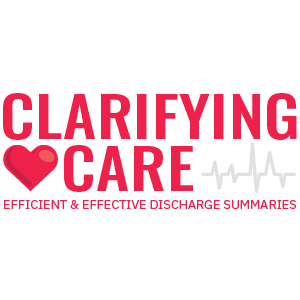Clarifying Care: Efficient and Effective Discharge Summaries
MVP Site
Feel free to visit our website where we host additional details about our mission, work and team: Clarifying Care
Problem & Motivation
Over 33 million people are admitted to the hospital each year in the US.
A discharge summary is produced by the doctor and is often the only source of written communication to the patient and their future healthcare providers about what took place and any follow-up care needed.
Doctor’s find discharge summaries tedious and error prone to produce and patients often find them overly technical and difficult to understand which can impact their adherence to the follow-up care instructions. This confusion and lack of adherence can result in unplanned readmission, which is estimated to cost $15-20 billion annually in the US.
Solution
Clarifying Care queries the data commonly captured in electronic health care records and utilizes machine learning to generate a well organized patient-friendly discharge summary.
Ultimately our solution will save doctors time and reduce errors while producing an output that is more understandable and easier to read for patients.
See a demo and more key features at our site: Clarifying Care App
Data Source & Data Science Approach
Discharge Summary Notes from MIMIC IV Dataset.
- Dataset of hospital and intensive care unit (ICU) admissions from 2008-2019
Clarifying Care's tool leverages Langchain along with a local quantized version of the Llama 2 LLM. Through prompt engineering we molded the output to follow industry best practices and enhanced utility with expert feedback.
Evaluation
Two method of evaluation:
1) Survey assessing end user (patient) ratings of Clarifying Care
2) Readability score metrics
Key Learnings & Impact
Based on subject matter expert interviews with board certified physicians and nurses, better medication instructions and explanations help patients to follow instructions and prevent readmission. Guided by this feedback, the Clarifying Care discharge summary was organized to include medication instructions first, focusing on explaining the prescribing instructions and uses for the medication. In a survey of users from the general public, 92% preferred the medication instructions from Clarifying Care output compared to the original hospital medication instructions. Additionally, survey respondents scored an example Clarifying Care discharge summary as high on explainability, usefulness, and patient friendliness.
The Dale Chall readability score was selected to quantify Clarifying Care’s impact on readability. This readability metric provides a grade level estimate based on the proportion of complex words vs. standard words present. Clarifying Care achieved at least one full grade level decrease in language complexity, achieving an average output score of 8.21 (11th to 12th grade) compared to the medical notes input average of 9.29 (college level).
Acknowledgements
Thank you to our capstone supervisors, Korin Reid and Fred Nugen, for their guidance, insights, and expertise throughout this project.
Furthermore we give thanks to the guidance and direction from our subject matter experts in the medical industry Dr. Andy Peiffer MD, PhD, Dr. Anna Woods, MD, and Sara Fenton, RN










